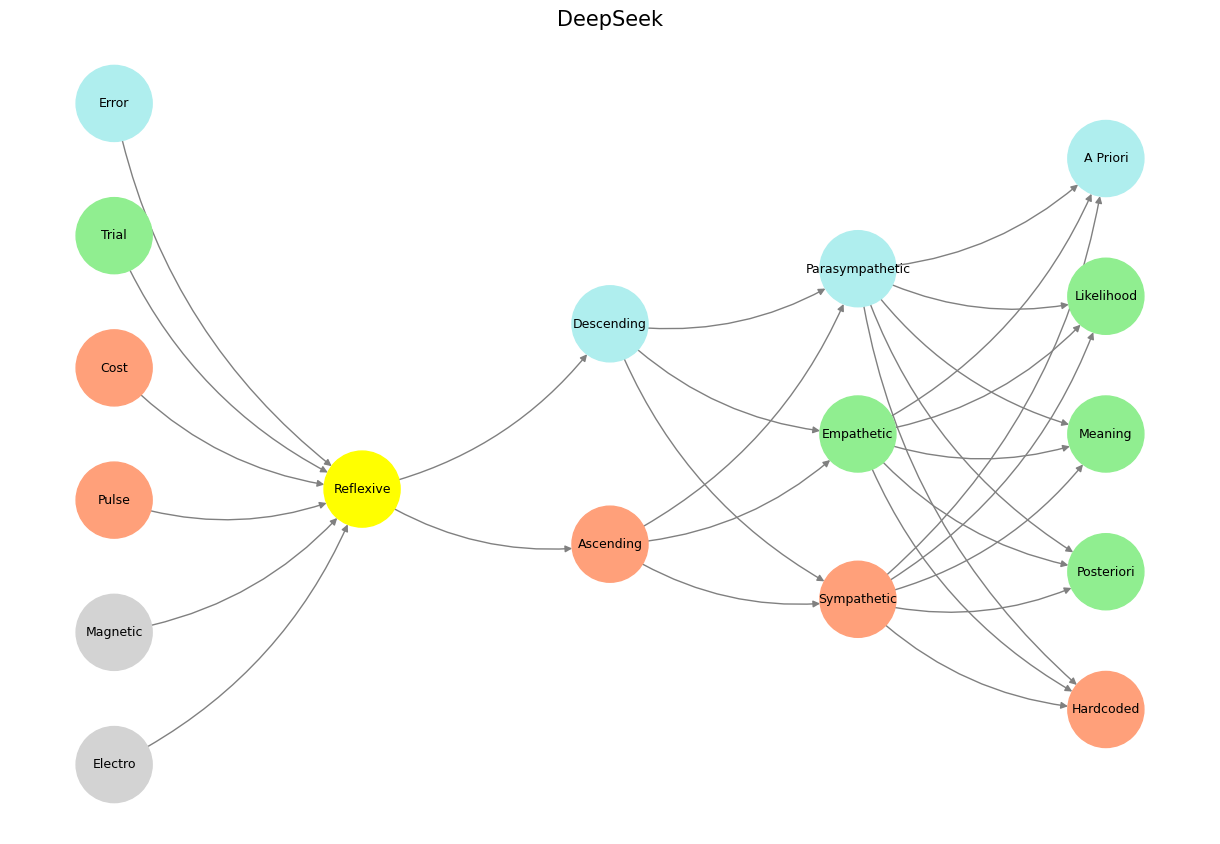Veiled Resentment#
The edges between nodes represent cadences, which are the emotional transitions or shifts that occur as one emotion flows into another. These cadences are not merely connections but are imbued with meaning, reflecting the tone, pace, and quality of emotional change. For example, the transition from ‘Electro’ to ‘Reflexive’ might represent a sudden, jarring cadence, akin to a sharp, staccato rhythm, where a raw, intense emotion triggers an immediate, instinctive response. This cadence could be described as “tragical,” as it conveys a sense of urgency or inevitability, much like the abrupt shifts in a tragic narrative.
In contrast, the cadence between ‘Reflexive’ and ‘Ascending’ might be more fluid and uplifting, resembling a rising melodic line. This transition could be described as “comical,” as it suggests a shift from a reactive state to one of growth or optimism, mirroring the lighthearted, upward trajectory of comedic storytelling. Similarly, the cadence between ‘Ascending’ and ‘Sympathetic’ might be smooth and harmonious, reflecting a pastoral quality—a gentle, flowing transition that evokes a sense of peace and connection, like the serene rhythms of a pastoral poem.

Fig. 23 Ecological Cost vs. Optimized Efficiency. Nietzsche’s focus on “values” and the “transvaluation” of all values or of postmodern mankind, alienated (in Marxist sense), because they “killed god”. His prophetic soul!#
The cadence between ‘Sympathetic’ and ‘Hardcoded’ could be described as “historical,” as it represents a grounding or anchoring of emotion in something enduring and unchanging. This transition might feel deliberate and weighty, like the measured pace of a historical narrative, where emotions are contextualized within a broader, timeless framework. On the other hand, the cadence between ‘Empathetic’ and ‘Likelihood’ might be more tentative and exploratory, reflecting a “pastoral” quality—a gentle, meandering transition that evokes curiosity and openness, much like the wandering rhythms of a pastoral scene.
The cadences within the ‘Time’ layer are particularly rich in meaning. For instance, the transition from ‘Hardcoded’ to ‘Meaning’ might be described as “philosophical,” as it represents a shift from fixed, ingrained emotions to a deeper search for significance and understanding. This cadence could feel contemplative and deliberate, like the measured pace of a philosophical discourse. Similarly, the cadence between ‘Likelihood’ and ‘A Priori’ might be described as “theoretical,” as it reflects a shift from probabilistic, experience-based emotions to those rooted in innate knowledge or intuition. This transition could feel abstract and intellectual, like the structured rhythms of a theoretical argument.
The colors assigned to the nodes further enhance the cadences by providing visual cues for the emotional tone of each transition. For example, the shift from ‘lightsalmon’ (intense, urgent emotions) to ‘paleturquoise’ (calm, introspective emotions) might represent a cadence that moves from tension to resolution, akin to the resolution of a musical phrase. Similarly, the transition from ‘lightgreen’ (growth, renewal) to ‘yellow’ (alertness, caution) might represent a cadence that introduces a note of uncertainty or hesitation, like a sudden modulation in a musical composition.
In summary, the cadences in this neural network fractal are the emotional rhythms that connect and animate the nodes, giving structure and flow to the emotional landscape. Each cadence carries its own unique quality—tragical, comical, historical, pastoral, or philosophical—shaping the emotional narrative and reflecting the dynamic interplay of emotions within the neural anatomy. By focusing on these cadences, we gain a deeper understanding of how emotions transition and evolve, creating a rich, multi-layered tapestry of human experience.
Show code cell source
import numpy as np
import matplotlib.pyplot as plt
import networkx as nx
# Define the neural network fractal
def define_layers():
return {
'World': ['Electro', 'Magnetic', 'Pulse', 'Cost', 'Trial', 'Error', ], # Veni; 95/5
'Mode': ['Reflexive'], # Vidi; 80/20
'Agent': ['Ascending', 'Descending'], # Vici; Veni; 51/49
'Space': ['Sympathetic', 'Empathetic', 'Parasympathetic'], # Vidi; 20/80
'Time': ['Hardcoded', 'Posteriori', 'Meaning', 'Likelihood', 'A Priori'] # Vici; 5/95
}
# Assign colors to nodes
def assign_colors():
color_map = {
'yellow': ['Reflexive'],
'paleturquoise': ['Error', 'Descending', 'Parasympathetic', 'A Priori'],
'lightgreen': ['Trial', 'Empathetic', 'Likelihood', 'Meaning', 'Posteriori'],
'lightsalmon': [
'Pulse', 'Cost', 'Ascending',
'Sympathetic', 'Hardcoded'
],
}
return {node: color for color, nodes in color_map.items() for node in nodes}
# Calculate positions for nodes
def calculate_positions(layer, x_offset):
y_positions = np.linspace(-len(layer) / 2, len(layer) / 2, len(layer))
return [(x_offset, y) for y in y_positions]
# Create and visualize the neural network graph
def visualize_nn():
layers = define_layers()
colors = assign_colors()
G = nx.DiGraph()
pos = {}
node_colors = []
# Add nodes and assign positions
for i, (layer_name, nodes) in enumerate(layers.items()):
positions = calculate_positions(nodes, x_offset=i * 2)
for node, position in zip(nodes, positions):
G.add_node(node, layer=layer_name)
pos[node] = position
node_colors.append(colors.get(node, 'lightgray'))
# Add edges (automated for consecutive layers)
layer_names = list(layers.keys())
for i in range(len(layer_names) - 1):
source_layer, target_layer = layer_names[i], layer_names[i + 1]
for source in layers[source_layer]:
for target in layers[target_layer]:
G.add_edge(source, target)
# Draw the graph
plt.figure(figsize=(12, 8))
nx.draw(
G, pos, with_labels=True, node_color=node_colors, edge_color='gray',
node_size=3000, font_size=9, connectionstyle="arc3,rad=0.2"
)
plt.title("DeepSeek", fontsize=15)
plt.show()
# Run the visualization
visualize_nn()


Fig. 24 Vet Advised When to Sell Horse. Right after an outstanding performance. Because you want to control how its perceived, the narrative backstory, and how its future performance might be imputed. Otherwise, reality manifests with point and interval estimates. This is the subject matter of the opening dialogue in Miller’s Crossing.#

